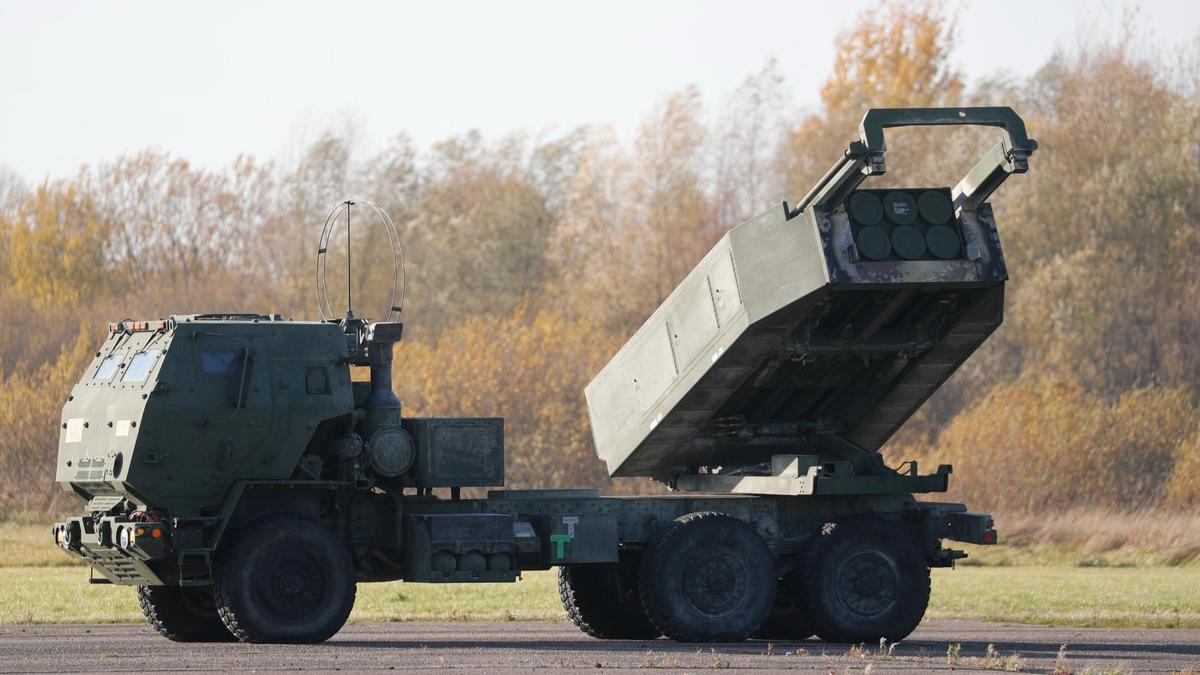The first phase of Russia’s war in Ukraine, which implied taking Kyiv in three days, has long been lost. Just as the second one, intended to cut Ukraine off from the sea
And yet many still had the illusions (or worries, or hopes) that, at least in Donbas, the Russian army, merciless and menacing like a glacier, would keep sliding down upon the Ukrainian positions, grinding the Ukrainian defense lines with a rolling barrage and heaping cannon fodder upon whatever is left of them; that Putin, having overwhelming superiority in military equipment and munitions (with 20 Russian artillery rounds per one Ukrainian) would enforce a war of attrition on Ukraine and would ultimately win it.
Last week has ruined this illusion. Russian front, or to be more precise, its rear 60 to 80 kilometers in depth, is on fire now. Ablaze are a warehouse in Khrustalny (Krasny Luch), dozens of depots in Donetsk, equipment at an airfield in Melitopol, storage facilities in Kherson and Nova Kakhovka, and even Chornobayivka is afire again. The next day after Russian forces took Lysychansk, a huge divisional warehouse in Popasna burned down. Had this happened a couple of days before, perhaps the Russians would’ve had nothing to take Lysychansk with.
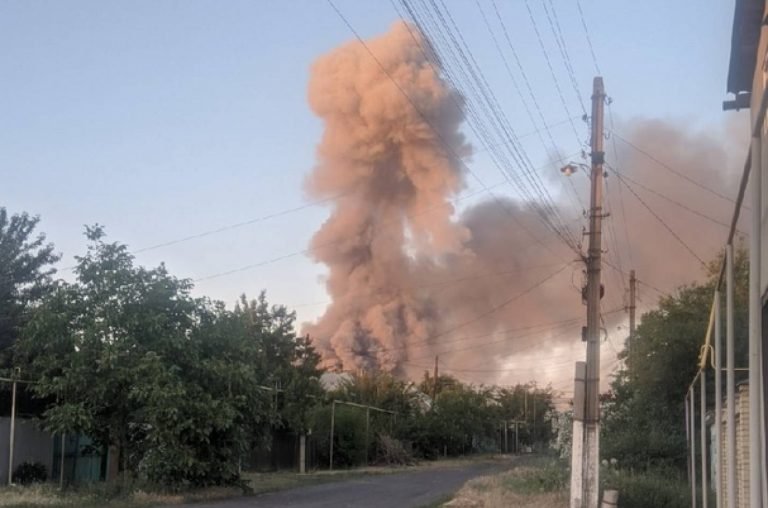
Fire at the ammunition depot in Krasny Luch. Photo taken from social media
Burning away are not just ammunition depots, but the Russian offensive. Burning away is Stalin’s war strategy inherited by Russian generals, which means advancing with cannon fodder following a rolling barrage and covering large areas with random and aimless airstrikes. After taking Lysychansk, the Russians ventured an offensive along the entire frontline (right after Putin declared an “operational pause”), but it stalled immediately for lack of munitions.
Ukraine’s precision firing with missiles upon warehouses contrasts starkly with the Russian firing with expensive missiles upon residential neighborhoods, shopping centres, and city squares.
Retired Colonel Roman Svitan, a former Ukrainian military pilot, has estimated the share of destroyed Russian ammunition depots at 15 to 20%. Obviously, the Ukrainian army will not start an offensive until it destroys all the depots.
It goes without saying that the depots are being destroyed with HIMARS, namely M142 High Mobility Artillery Rocket Systems, mounted on a standard U.S. Army M1140 truck frame, which carries one pod with six GMLRS missiles. An alternative version of the launcher can carry one ATACMS missile with a range of up to 300 kilometers, although such missiles have not yet been supplied to Ukraine.
HIMARS boasts a large number of advantages. Firstly, it is mobile like a regular truck. This means that HIMARS can move along regular roads, reach a launch site, fire missiles, and then flee immediately at 80 km/h. It’ s hard to take it out with a retaliatory strike.
Secondly, the GMLRS missiles (with G for “guided”) used by HIMARS are GPS-guided and strike a target with pinpoint accuracy. This is what makes it different from the Smerch, Grad, and Uragan systems, which the Russians use to strike large areas.
Thirdly, again, unlike Russian Smerch systems, HIMARS does not need a loading machine. It simply approaches a pod previously loaded with missiles and lying on the ground, picks it up, and — voila! — it is ready to be used.
The use of HIMARS nullifies the entire logistics of the Russian army. The Russian army typically fights as follows: it sets up huge warehouses 60 kilometers away from the frontline and delivers everything from those warehouses by trucks. “If it’ s located 60 kilometers away, this means one truck can make three rides a day, if it’s 90 kilometers, it’s two rides, and if it’s 120 kilometers, it’s only one. The Russian army can advance only if its trucks can make three rides a day,” Ukrainian presidential advisor Oleksiy Arestovych says.
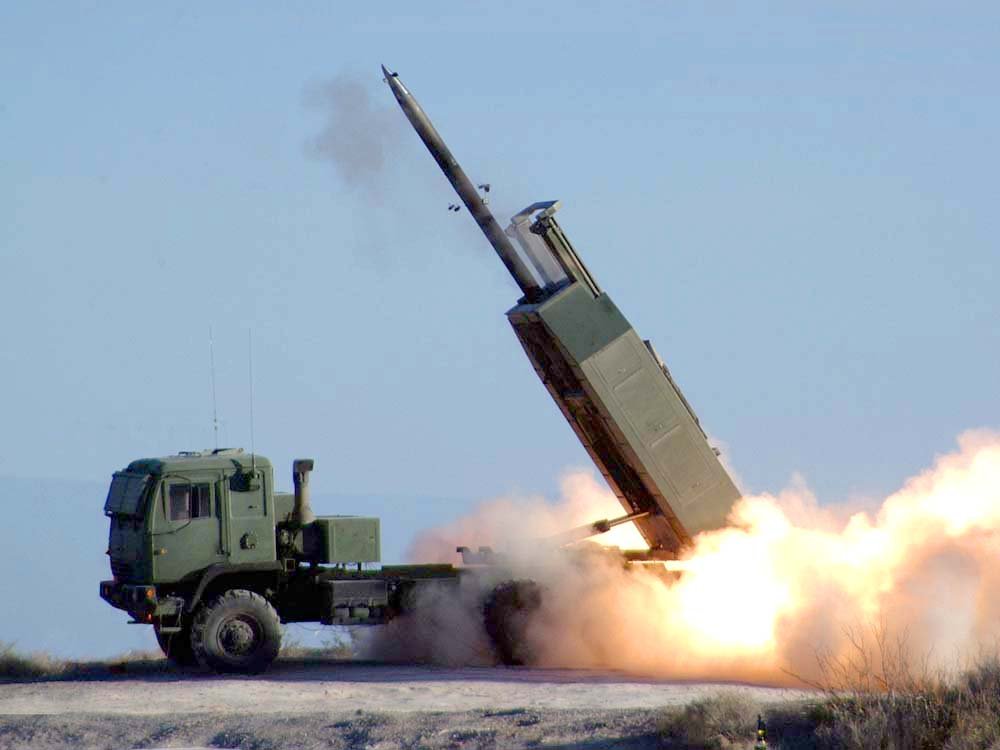
U.S. Army photo
The deployment of HIMARS confirms two points I’ve already formulated before. Firstly: Modern network-centric warfare always beats Stalin’s 1941-era “creeping barrage plus cannon fodder” concept. And secondly: Putin has failed to turn this war into trench warfare, which he sought to do, because trench warfare implies that your opponent can see only the frontline and cannot strike key military infrastructure targets behind it accurately enough.
“What kind of a military machine has Putin built if four HIMARS systems can put an end to it?” Arestovych says sarcastically.
Truth be told, Ukraine already has a bit more than just four HIMARS systems. Oleh Zhdanov, a retired colonel, military expert and former member of the Ukrainian Armed Forces General Staff, told me that “Ukraine has 17 American HIMARS systems and their analogues,” and Arestovych confirmed that they had actually arrived “about a week before” this was announced officially.
This means that Khrustalny, Kadiyivka (Stakhanov), Snake Island, and the S-300 systems destroyed near Kherson about ten days ago are also HIMARS’s doing.
The U.S. employed HIMARS in Afghanistan, in Syria, and in Iraq, but the results of that use were not nearly as destructive as in Ukraine. Why? It’s very simple. To be successful, HIMARS requires three things: a clear-cut frontline, good roads on the one side of this line, and huge depots on the other. None of this was in place in Syria, and driving there was quite unsafe. Nor were there clearly identified targets, as ISIS did not build gigantic stocks of munitions while preparing to advance with a huge number of troops following a rolling barrage.
HIMARS and Russian military tactics have proven to be a perfect match.
Ukrainian forces use HIMARS mainly at nighttime. During the day, they are most likely hidden in some hangars to be invisible to Russian Orlan drones. Firing at night has another advantage. “Night firing minimises the risk of striking civilians,” says Roman Svitan. This also distinguishes the Ukrainian army’s tactic from Russia’s, which fires missiles at daytime.
How does Ukrainian intelligence know what to aim HIMARS at? How does it identify a Russian ammunition depot? Again, owing to network-centric warfare. Military expert Pavel Luzin believes the Ukrainian Armed Forces are using regular commercial satellite imagery provided by Maxar Technologies.
“Maxar takes photos twice a day, and using special software and Big Data, you can easily detect where depots are located and where military trucks travel,” says Luzin.
It would be logical to wonder what keeps Russia from using the same satellite imagery to find out where HIMARS trucks move.
The wonderful answer is: Russia has no access to Maxar services or any other commercial satellite images that would enable it to conduct net-centric warfare. You are likely to exclaim now: But Russia has its own satellites! That is true, it does. Those are military satellites that can take photos from space once in a few weeks.
Russia also has Resurs satellites, which used to be assembled of Western components. The US banned those components from being sold to Russia by instituting special legislation after Russia meddled in American elections, and now all of the Resurs satellites exhausted their service lives. The last one deorbited in December 2021. Russia also has three Bars satellites, but this is far from enough.
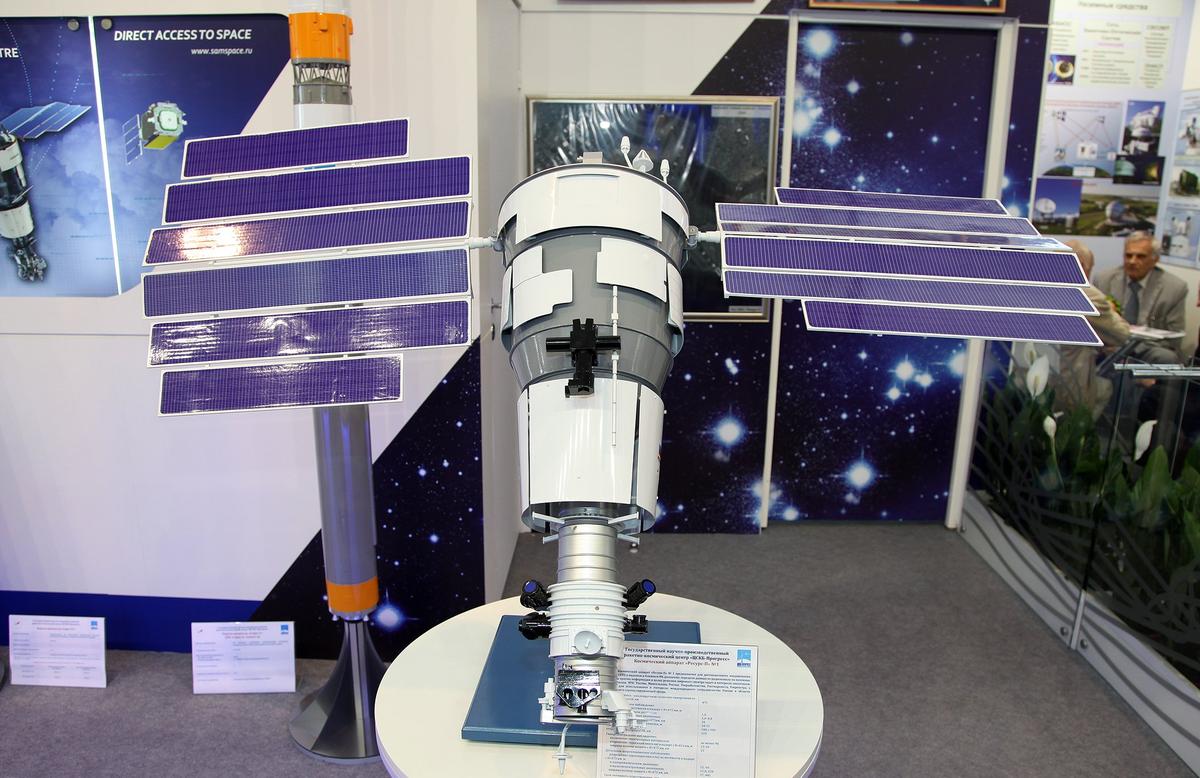
Model of the satellite "Resurs-P". Photo: Vitaly V. Kuzmin
That is, just as we showed in one of our previous articles, Russia identifies its targets at random, and yet it regularly misses even them.
In other words, Russia is again losing not just to the Western military system, but to the Western military system combined with civilian technologies. Commercial Maxar satellites, which were designed for absolutely different purposes, easily solve a problem that appears unsolvable for the whole Russian satellite constellation, on which billions have been wasted.
Similarly, Elon Musk’s civilian Starlink equipment proved invulnerable to Russian electronic warfare (EW) systems, on which billions have been wasted, as well. And the Ukrainian Kropyva artillery fire control system assembled of civilian tablet computers, civilian walkie-talkies, and cheap civilian drones significantly enhanced the efficiency of Ukrainian artillery back when both parties used old Soviet cannons and howitzers.
This could be viewed as a manifestation of yet another trend, namely that toward civilianizing of military technology, if you will.
The entire Russian defense industry operates based on the premise that there are some perfect super-secret military technologies, which have no parallels in the civilian industry.
However, the real modern world is quite different. Its highest-quality technologies, devices, and solutions are applied in billions of products. Such technologies are civilian by definition, as the military does not need billions of items. The defense market is just not that big. This erases the borderline between civilian and military technology in the West. The top-10 largest contractors of the U.S. Department of Defense sell 54% of their products on the open market. In Russia, by contrast, companies that cannot compete on the open market win closed tenders for military supplies. This automatically makes their technologies uncompetitive. They simply lie about their achievements. And this becomes obvious only when their products, after all, have to compete with Western ones on the most competitive of all markets: a battlefield.
This is precisely what happened to the S-400 air defense system. Russian jingoist media and the S-400 manufacturers boasted that it would knock HIMARS missiles down like walnuts from a tree. To put it plainly, they lied.
An S-400 missile cannot intercept a HIMARS missile for a number of reasons. Firstly, an S-400 missile cannot do that for the very simple reason that solid propellant used in a HIMARS missile is far more advanced. “It simply flies faster,” says Pavel Luzin.
Secondly, Ukrainians might sometimes oversaturate Russian air defenses by firing too many targets simultaneously. “They fire a swarm of Smerch or Uragan missiles along with a HIMARS missile,” Luzin says.
The third possible reason is that the S-400 was likely created at the time when the Almaz-Antey air defense corporation was headed by Igor Ashurbeyli. This wonderful man is known to have brought the Leningradsky Market in Moscow to heel during the perestroika era, then he joined the management of Almaz-Antey, whose premises were rented out as market warehouses at the time, and then he built the omnipotent S-400 system for Putin. Seasoned missile experts whom I interviewed doubted that a man who made a career on retail markets in the 1990s could have managed to build state-of-the-art missiles.
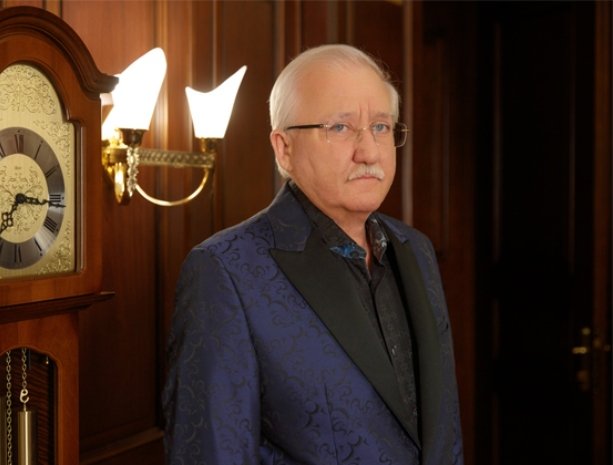
Igor Ashurbeyli. Photo: vpk-news.ru
Mr. Ashurbeyli currently introduces himself as the King (!) of the Space Kingdom of Asgardia, and as such, he even took an oath at the UN mission in Vienna.
Simply put, the King of Asgardia’s S-400 missile cannot intercept HIMARS, period. And it’s just ridiculous to refer to the Russian EW system worth billions. After all, a HIMARS missile flies for over 80 kilometers, while the frontline is 1,400 kilometers long. You just can’t provide EW coverage over such a huge area — it’s like trying to put out a wildfire with a garden hose.
A common joke about the power of official propaganda in Russia says that it looks like a battle between the fridge and the TV set. But if it appears that the fridge has completely lost this battle to the TV set inside Russia, it would also be fair to say that the TV set is hopelessly losing its battle to HIMARS in Donbas.
Heroism plus HIMARS can achieve much more than mere heroism.
The main question now is: What exactly will Putin do when he comes to understand that he is losing? For the time being, as Roman Svitan says, Russian aircraft have been flying Belarusian skies increasingly more often, and the A-50, an airborne early warning and control aircraft analogous to AWACS, has also been regularly noticed there. Simultaneously, Russia is deploying more and more Iskander missiles close to the Belarusian-Ukrainian border. These missiles have a range of up to 500 kilometers and are clearly designed to reach targets deep behind the enemy lines.
“All of this looks like preparations for a massive missile strike, including upon bridges and other infrastructure,” Svitan says.
Join us in rebuilding Novaya Gazeta Europe
The Russian government has banned independent media. We were forced to leave our country in order to keep doing our job, telling our readers about what is going on Russia, Ukraine and Europe.
We will continue fighting against warfare and dictatorship. We believe that freedom of speech is the most efficient antidote against tyranny. Support us financially to help us fight for peace and freedom.
By clicking the Support button, you agree to the processing of your personal data.
To cancel a regular donation, please write to [email protected]
